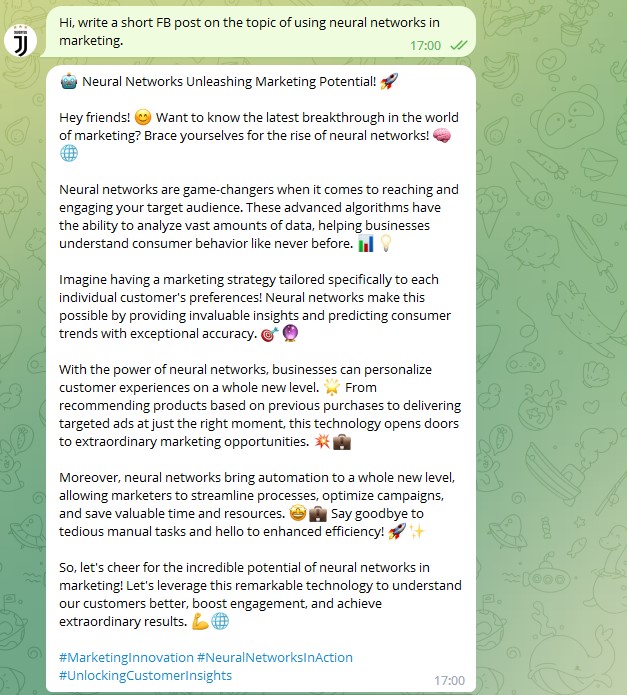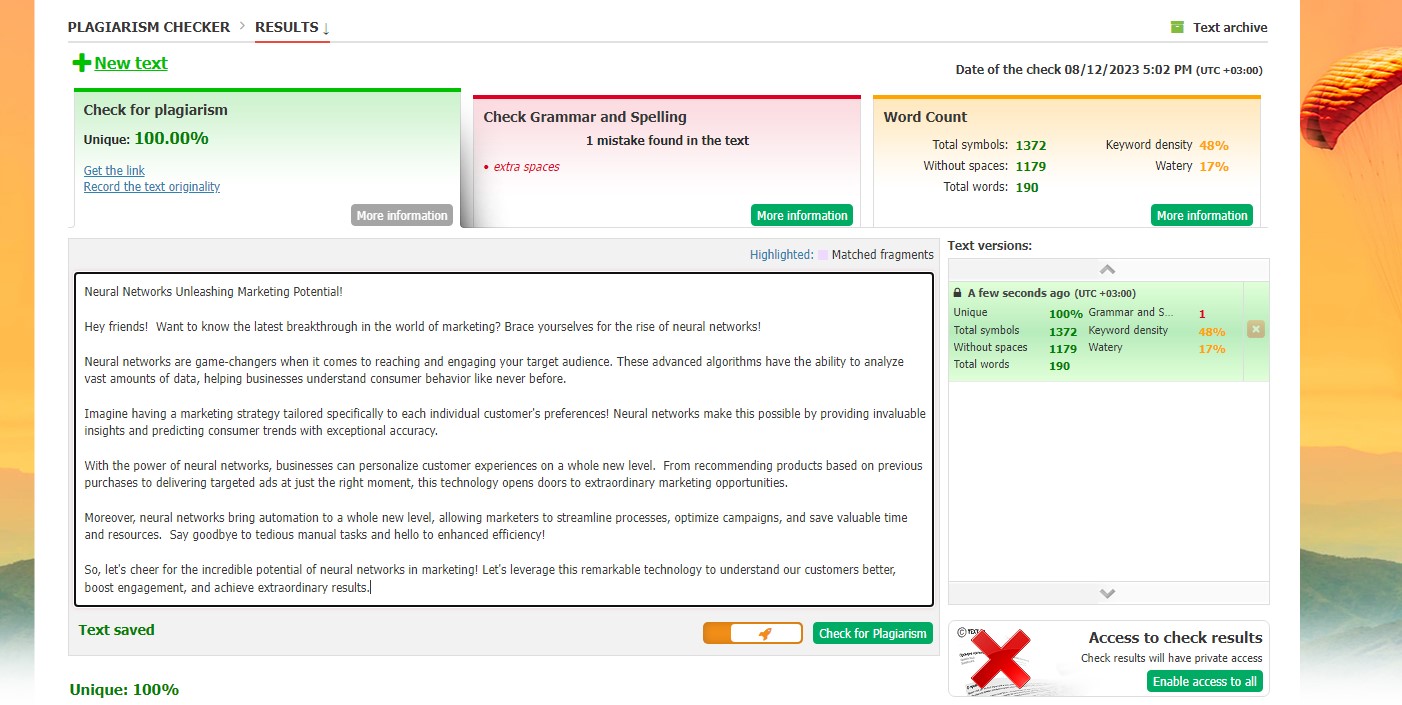The Application of Neural Networks in Marketing: Can AI Replace Traditional Marketers?
Contents
What are neural networks and where are they applied?
Currently, neural networks can
Advantages of Neural Networks for Business
How Neural Networks are Applied in Marketing
Content Generation without Human Involvement
Neural networks are mainly used in two areas
Improving advertising effectiveness

Neural networks have become a prominent trend in 2023, with almost everyone hearing about them. Although this technology has been developed since the 90s, it gained popularity in 2022-23. Neural networks gained traction as projects like ChatGPT began successfully tackling real-world tasks. They are now capable of generating content, analyzing data, and more, making them a valuable tool in a marketer's arsenal.
In this article, we will examine how neural networks are applied in business, their value, and the existing tools.

What are neural networks and where are they applied?
A neural network is a mathematical model that processes information similar to the human brain's nervous system. Unlike primitive systems, neural networks can solve complex tasks without a pre-programmed algorithm and predictable outcomes.
The main feature of this technology is its ability to learn. Neurons automatically adjust based on task performance results to achieve maximum accuracy or at least meet the user's needs.
Initially, neural networks were used solely for complex computations, as they could quickly and accurately solve tasks that required significant human labor. However, AI has since acquired more functions, benefiting not only software developers but also copywriters, artists, marketers, and other professionals.
Currently, neural networks can:
- Generate images, texts, and audio (even songs).
- Colorize images.
- Enhance photographs.
- Analyze data, etc.
Additional functions, such as computer vision and user communication in chat, can be implemented if desired. The possibilities of artificial intelligence are limited only by the developer and the architecture.

Advantages of Neural Networks for Business
Companies are actively implementing neural network technology because it provides them with three advantages:
- Increased productivity. Neural networks can quickly process and generate large amounts of information. While it might take a human employee several days to create a painting, artificial intelligence can create it in a matter of seconds.
- Autonomy. Once the algorithms are created, neural networks do not require a trainer. They can learn on the job, just like ChatGPT. Therefore, companies do not have to invest a lot of money in training AI after its creation.
- Cost savings. Neural networks do not require a salary, social contributions, or vacation time. It is enough to pay a subscription for ready-made solutions or pay once for the creation of your own AI. In the long run, content production can be much cheaper than hiring a specialist.
Additionally, neural networks are often assigned typical and monotonous tasks so that employees can focus on more complex goals that cannot be achieved without human involvement.

How Neural Networks are Applied in Marketing
Neural networks are primarily utilized for advertising purposes. They help generate a lot of content and analyze the target audience based on more parameters than was previously possible.
Personalization
By connecting the system to a database, it can deeply analyze user behavior based on Big Data. In 2023, business neural networks gather and study a vast amount of information that humans cannot handle.
Thanks to artificial intelligence, recommendation systems have emerged. For example, platforms like Kinopoisk, Netflix, TikTok, and others employ AI to offer users relevant and interesting content. Internet stores also create personalized advertising emails.
Content Generation without Human Involvement
Neural networks are mainly used in two areas:
Texts. Services are capable of generating articles, comments, and social media posts. Moreover, marketing neural networks are valuable in providing the optimal structure for large texts if one is unable to do it themselves.
For example, let's take the Telegram ChatGPT bot, which now offers the free service of SMS activations called "Tiger SMS." Let's say we need a FB post on the topic: "How to Use Neural Networks in Marketing." We write to the bot in a free form, for example: "Hi, write a short FB post on the topic of using neural networks in marketing." And this is what the neural network suggests to us.

Let's now check the post for uniqueness using one of the services.

Not a bad result in terms of content and uniqueness, don't you think?
- Images, audio, and video. These are mainly tools used for creating images. They can quickly generate images in various styles, including photorealistic ones.
The key is to correctly formulate the query, describing the task details. If the prompt is too broad, the AI simply won't understand what is specifically required.
Here are a few example photos generated by the "Stable Diffusion" neural network:

Content analysis
Neural networks significantly simplify the execution of complex analytical tasks related to studying Big Data, object recognition in images, etc. For example, when connecting AI to a video surveillance system, it is possible to collect and analyze data on the attendance of sales offices, visitor satisfaction levels.
The neural network identifies patterns, draws conclusions, and predicts future events. Analytical models can predict product demand based on statistical data. AI performs technical analysis effectively and provides additional information that complements the conclusions of marketers.
Developers have created a special neural network for analyzing public opinion and comment sentiment in 15 languages - Luminoso. The only drawback is that manual information loading is required. The system can identify connections and compile information into diagrams. Based on the predictions of the neural network, it is possible to optimize the quantity of purchases, predict a decline in demand, and prepare a discount promotion.
In the future, neural networks for business will become automated tools for marketing research. Thanks to them, analytics will become significantly cheaper and faster.
Improving advertising effectiveness
Neural networks are used to optimize advertising campaigns. This task lies at the intersection of analytics, personalization, and content preparation. For example, the company implemented neural networks to search for people wearing glasses on FB and sent them relevant offers. Thanks to AI, the company expanded its target audience by 4 times.
Neural networks simplify content production and analysis, allowing for the preparation of various data variations and conducting research at minimal costs.
Top 4 neural networks for business
Let's consider 4 popular projects that are actively used by companies to solve marketing tasks.
ChatGPT

ChatGPT is the best project in the field of neural networks and artificial intelligence. It was developed by OpenAI, which has become a leader in the industry. Currently, ChatGPT has the best performance in text generation. It can mimic human speech, reason on philosophical topics, and create scientific papers.
The model learns speech during interaction with real people.
What it can do:
- Write texts of different formats (articles, posts, notes, business letters).
- Translate into another language.
- Generate hashtags for SEO optimization.
To use the service, registration on the website is required. There is a paid subscription that expands the functionality of the neural network and speeds up query processing.
DALL-E 2

DALL-E 2 is a neural network that generates images from text descriptions. It creates original artworks based on user input. The images resemble real-life paintings created by professional artists. Users can upload their own images and edit them using text prompts.
Capabilities:
- Creating images based on text descriptions.
- Refining existing paintings.
The key feature of DALL-E 2 is the ability to adhere to a chosen style. The neural network can create artwork in the style of Renaissance paintings, anime, or Russian postmodernism.
Users have access to 200 free image generations in the first month and 60 per month thereafter. To expand the tariff, they would need to pay $15 for 460 requests.
You.com

You.com is a new search engine that can answer any question using materials from the internet. It can engage in dialogue with users and provide detailed information on virtually any topic.
Capabilities:
- Generating headlines and social media posts.
- Creating emails and texts in various styles.
- Drawing paintings.
The first 10 texts or images can be created for free without creating an account. After that, users need to purchase one of the subscriptions starting at $10.
CopyMonkey

CopyMonkey is a service for generating textual content. Initially, the platform was focused on e-commerce and created short product descriptions based on specifications. The developers later added more features, including support for multiple styles and the ability to choose specific text tasks.
Generates:
- SEO articles.
- Social media posts.
- YouTube video descriptions.
- Product cards.
Users can create 10 articles after registering for an account. To continue using the service, they would need to pay a subscription starting at 1599 rubles per month.
In conclusion
Neural networks are a promising technology that is now accessible to companies of any size, not just large corporations. Artificial intelligence can be used to optimize content production, information analysis, personalize advertising offers, and create reliable recommendation systems.
However, it is essential to check the generated content for plagiarism. The results of working with AI-generated data cannot be predicted, which can sometimes lead to images and texts that are nearly identical to those they were trained on. This is crucial from a copyright and SEO perspective.
Furthermore, it should be noted that neural networks cannot yet replace professionals. Companies still require strong marketers, copywriters, and artists.

